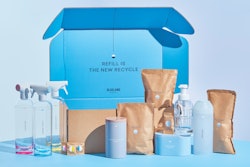[00:00:00] Welcome to Sustainable Packaging Explained, your guide to sustainable materials, methods, and package design, produced by the Emerging Brands Alliance in conjunction with Packaging World. Today's episode offers a look at packaging waste and advanced recycling. Plastics make up a large part of the ongoing waste issue in the United States.
To minimize this, packagers, manufacturers, and recyclers know that we need to increase the percentage of used plastic that gets recycled. Traditional recycling, also called mechanical recycling, is an important part of this, but it has limitations. For instance, feedstock containing missorted plastic waste and contamination from things like food affect how much can be recycled and the quality of the end products.
Increasing recycling rates requires technology that can handle a broader range of plastics and produce a higher quality plastic for use in a wider range of applications. That's where Advanced Recycling comes in. Advanced Recycling, also known as Chemical Recycling, is a technology that converts plastics into a purified form of feedstock that can be used in the production of new polymers, monomers, intermediates, [00:01:00] or other materials.
While Mechanical Recycling uses physical processes such as grinding, washing, separating, and compounding in which polymers remain intact, Advanced Recycling alters the chemical structure of plastics by methods such as dissolving with chemicals or using heat to break them down into original components.
Packaging world editor Matt Reynolds tells us more about advanced recycling. Advanced recycling is really an umbrella term for a collection of similar but disparate technologies. They range from full depolymerization or bringing that polymer down to its single unit or monomer level and then building that monomer up to a polymer again to the manufacturer's choice to less intrusive tech like solvents that clean polymers but don't break them down to that monomer level.
Pyrolysis and gasification are the most common examples of depolymerization in our wide ranging tools that accept a lot of different substrates, not just plastic. Meanwhile, some more targeted examples are meth analysis used by Eastman, and that's a depolymerization based method used specifically for PET.
There's also pure cycle, a [00:02:00] solvent based polypropylene chemical recycling process. It takes the polypropylene waste and creates a PP plastic pellet. Those are just a couple of examples. Now, some brands using chemically recycled material can make claims of using PCR, even though there's not always truly chemically recycled material in every package that they produce.
And that's based on what's called the mass balance approach, which is really an accounting of all the chemically recycled material going into and out of a facility or of a company. To the uninitiated, that can seem like smoke and mirrors, but other industries have gone through the same amounts of skepticism long before chemical recyclings, before that bio based plastics version of the mass balance approach.
Now, carbon credits and carbon offsets, for instance, or even clean energy credits in powering people's homes, were once seen as a means of fudging the numbers to make unrealistic claims. But as consumers and their energy, travel, and brand suppliers became more acquainted with those concepts, they largely have come around to the idea.
After some education and understanding bored confidence, these systems enjoy [00:03:00] widespread credibility today. Mass balance approach is a process of describing and accounting for the use of advanced recycled or bio based feedstock in a final product. When both recycled and virgin feedstock, or bio based and fossil based feedstock, have been used in the process of making that package.
Since advanced recycling is such a new technology, it's not often practical for a usage figure to even approach 100%, given how scarce it is. So the approach is really a matter of averages. Some of that chemically recycled material comes into the facility, and some leaves at the facility as packaging.
Mass balance just accounts for how much of it is used as part of the whole. The tech is following a similar adoption journey as predecessor technologies in other industries.[00:04:00]
Advanced Recycling complements existing mechanical recycling methods, allowing more types of used plastics to be recaptured and remanufactured into new plastics and products. Advanced Recycling produces materials that are indistinguishable from version plastic, so they can be used to make a wide range of new products.
Advanced Recycling is proving to be an important part of recycling and package waste recovery. Globally, the market for advanced recycling technologies is expected to exceed 9 billion by 2031, up from 270 million in 2022, according to a report from Research Markets, an industry analysis firm. The report noted that the key factor limiting the growth of the advanced recycling technologies market is a lack of collection and treatment infrastructure.
Thanks for watching and be sure to subscribe to our YouTube channel for more videos on sustainability, packaging, and scaling [00:05:00] operations.























